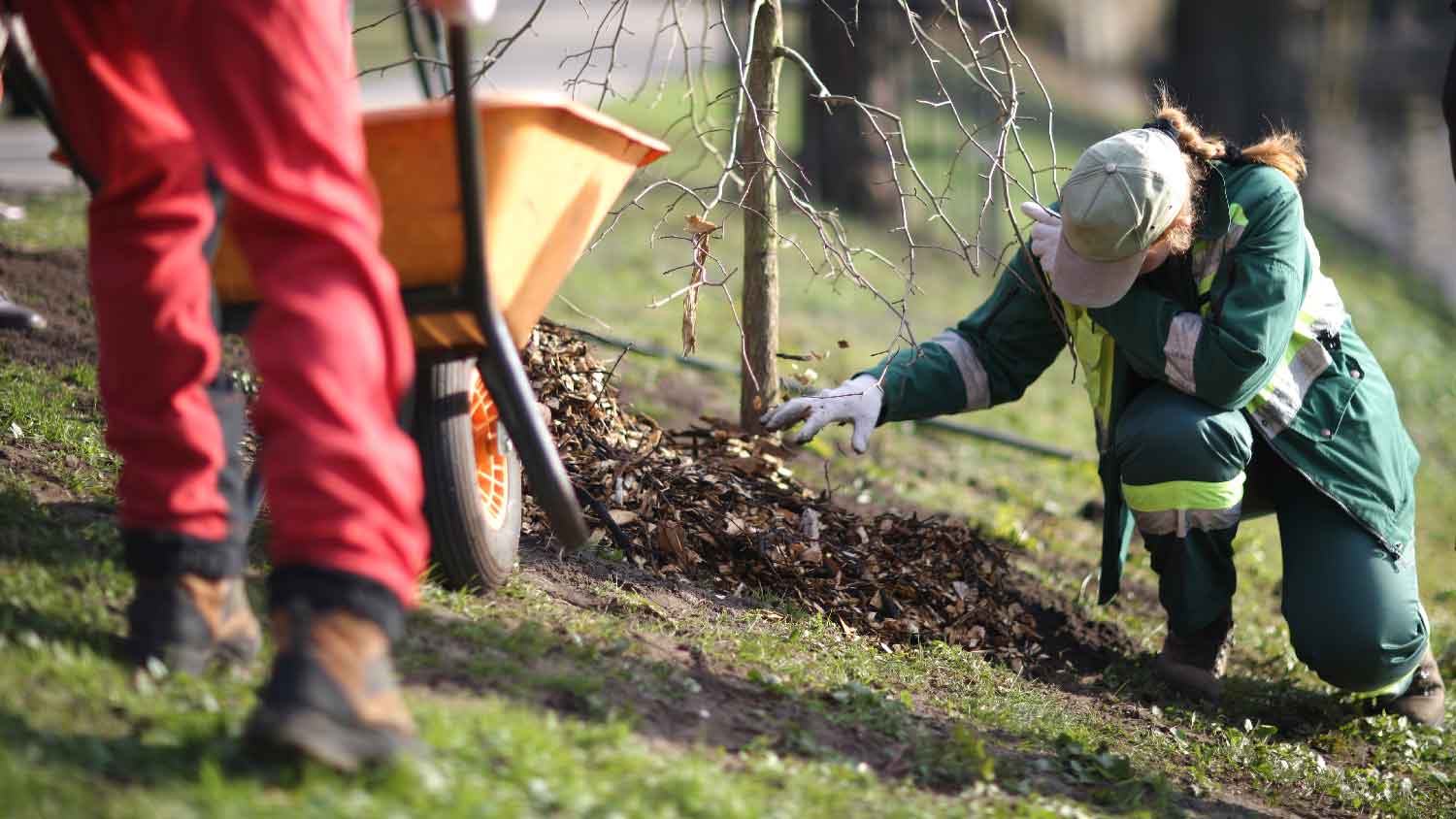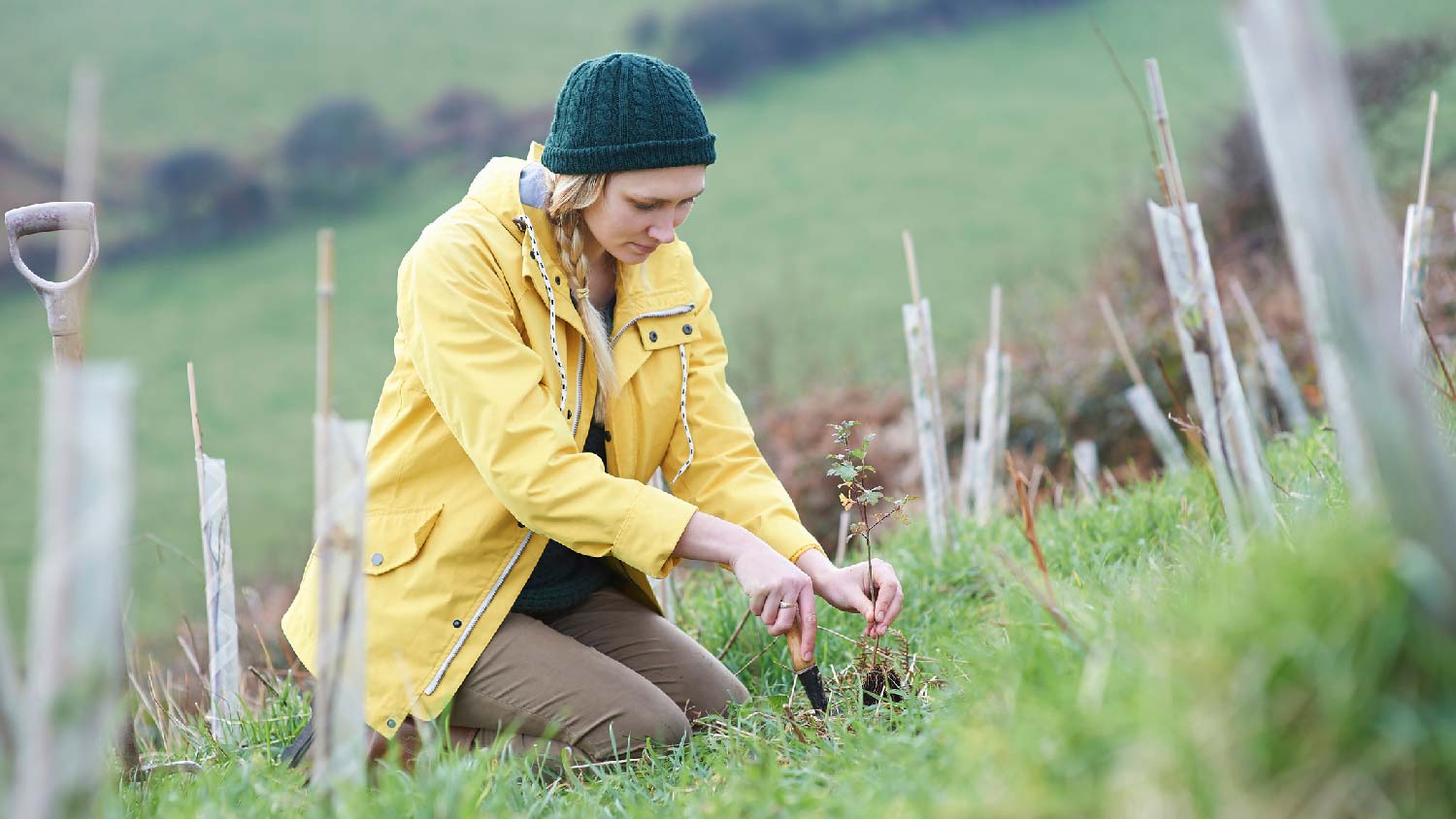
Get a clear estimate of palm tree maintenance cost, including trimming, fertilization, and pest control, so you can keep your palms healthy and your budget on track.
Sloping lawns can be beautiful, too


The cost for a professional to plant a tree averages $300, but they help protect your tree’s long-term health and ensure proper placement.
On sloped ground, improper planting can lead to erosion or water runoff, which exposes roots and weakens the tree.
Tree planting pros know how to contour the soil and position the root ball to give the tree the best chance of thriving on a slope.
DIYers will need to dig a wider, deeper hole than on flat ground—often by hand—which can be a labor-intensive task.
If you’re planting large trees, a local tree planting professional will have equipment to make the work go faster.
Understanding how to plant a tree on a slope involves simple soil and water management. Whether transplanting an existing tree or adding a new one to your landscaping, growing it on a slope simply requires an additional step or two over putting it on flat ground. Here are the four steps for hillside tree planting to help ensure success.
The primary differences between planting a tree on a slope versus flat ground are water control and minimizing erosion. We know that rainwater flows downhill, so capturing some of that water to feed the new tree roots instead of letting it flow by is essential to its survival, especially when it's young.
Stemming the water flow also reduces the potential for eroding a newly excavated hillside away and causing other yard grading issues. Of course, planting a tree on flat ground doesn't require overcoming those challenges, so they’re unique to adding a tree on a slope.
Planting a tree can be challenging and labor-intensive work. Before starting, make a plan, gather the necessary tools and materials, and wear protective gear like heavy duty gloves and eyewear. Call 811 before digging any holes on your property so the local utility company can perform an underground equipment survey first. The law requires this type of land survey to ensure your new tree doesn’t interfere with any electrical systems, preventing accidental and expensive damage to utility components.

The simplest way to envision planting a tree on a slope is to imagine creating a flat spot or a shelf cut into the hillside where the tree can rest easily.
To create the shelf where your tree will rest, use a shovel to dig back into the hillside several feet while placing some soil above and below the flat area. The shelf should be approximately twice as wide as the tree's root ball.
Create a hole directly in the center of the shelf area that's 1½ times wider than the tree's root ball. Dig deep enough so the base of the trunk rests even with an imaginary line that follows the hill's slope angle.
Place most of the soil from the hole above the spot you're working in for easy backfilling later. Aim for centering the tree on the shelf. If it’s placed too far into the hillside, it could have root trouble, while placing it too close to the edge can expose the roots.
After centering the tree in the hole, backfill around the root ball using the uphill soil. Use the leftover soil to create a berm, or bump, slightly extending the shelf area. This berm will help to capture water and minimize erosion. Consider building a small retaining wall below the tree on steep slopes to strengthen and help hold the berm in place.
Young and newly transplanted trees require a few steps to ensure they start strong. First, stake the tree in place if necessary, checking that the trunk stays vertical. Next, place a two- to three-inch layer of mulch around the tree, covering most of the shelf. However, avoid putting mulch up to the trunk and leave a few inches clear around it.
Finally, thoroughly water the new tree daily for the first couple of weeks and regularly after that, depending on the type of tree and its care instructions.

Planting a tree on a slope is more challenging than putting one on flat ground. Here are a few tips to help ensure its success.
Aim for dead-center when placing your tree on the shelf. Avoid covering any part of the root ball with the hill's slope or the berm soil.
Only mulch two to three inches deep. If you add too little, the mulch will be ineffective while adding too much can cause rotting problems by retaining additional water.
Try to minimize disruption to the hillside when planting on a slope to maintain the hill's stability.
While planting a tree is a common DIY project, it doesn't fit every homeowner's definition of a fun afternoon. Planting a tree on a slope adds to the challenges of normal tree planting. While we have confidence that you can pull off this task with the right tools and an extra set of hands, you can ensure the project’s success by hiring a professional planting service to tackle it for you.
Hiring a local tree planting service to perform the task will free up your weekend and help to ensure the tree gets its best chance at thriving in its new spot. The cost to plant a tree in your yard costs between $100 and $2,000, depending on the tree size, type, yard condition, and number of trees.
From average costs to expert advice, get all the answers you need to get your job done.

Get a clear estimate of palm tree maintenance cost, including trimming, fertilization, and pest control, so you can keep your palms healthy and your budget on track.

How much does it cost to rent a chainsaw? Whether it’s for cleaning up your yard or cutting firewood, learn what options are available and what you’ll pay.

How much does a palm tree cost? The answer depends on the type of tree, its size, and other factors. Find out how much a new palm tree costs.

If you have a strange branch growing from the roots of your tree, it might be a sucker. Here’s how to get rid of tree suckers without damaging your tree.

If your tree is still giving you grief after you remove it, knowing how to stop tree roots from growing back can ease your mind and keep your home safe.

If you’ve hired a tree service to trim your trees or remove them, you’ll have to decide whether to tip the pros afterward. Learn more about your options.